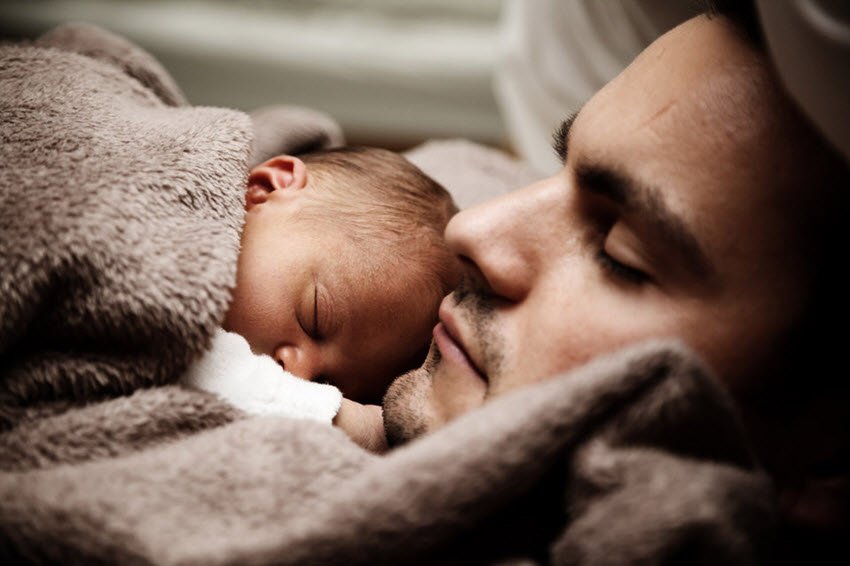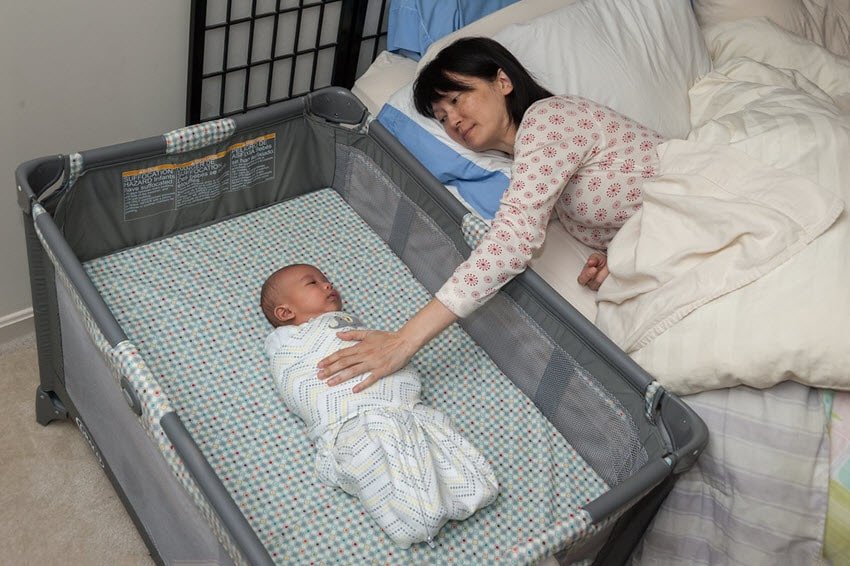Getting your baby on a proper schedule may be one of the most important things you can do for your little one’s well being — and your sanity. However, you may find yourself plagued with several questions as a new or expecting parent. Should my baby’s room be pitch black? How long should I let my baby sleep, and what exactly is sleep training?
Therefore, if you’re concerned about ensuring your child gets an adequate amount of sleep, continue reading.
Here are some of your top baby sleep related questions answered, so both mom and baby can learn to sleep peacefully through the night for a healthier and happier life!
Should Newborns Sleep in a Dark Room?
While darkness allows us to produce melatonin — providing us with higher quality sleep — your baby’s room doesn’t necessarily have to be pitch black for them to reap these benefits.
Yes, it’s important to block out large sources of light, such as the sun’s rays.
This also creates a calm, distraction-free environment for your baby to rest. But you don’t have to board up all the windows and doors either.
Instead, you can put up blackout curtains in your baby’s room, or limit your family’s screen time before bed as the blue light from the screen can also disturb their sleeping patterns.
Should I Leave a Light on For My Baby?
View in gallery
So how much light should you allow?
You want to have a modest light source so you can see your child if they cry out at night. Make sure to purchase a ‘fun’ superhero nightlight that they can appreciate as they grow into their toddler age.
- Colorful & Dimmable: Switch between warm white light 2700K, cool white light 6500K and color changing of vibrant RGB256 colors by tapping the bottom power button in turn. Brightness control by long pressing on the top when set in warm white/cool white mode.
- Magnet & Timer Features: Built-in magnet allows you to stick this touch lamp to metal surfaces such as a fridge door. For non-metal surfaces, you can use the included adhesive metal plate. The 1-hour timer is perfect for putting young children to bed.
- Long-Lasting Battery: The rechargeable 2200mAh built-in battery powers this kids night light for 6 hours on maximum brightness and 100 hours on the dimmest setting, and the lightweight cordless design makes it highly portable.
Prices pulled from the Amazon Product Advertising API on:
Product prices and availability are accurate as of the date/time indicated and are subject to change. Any price and availability information displayed on [relevant Amazon Site(s), as applicable] at the time of purchase will apply to the purchase of this product.
However, know that a nightlight is not completely necessary for a newborn as this solution is more for your sake as a parent.
If you choose to opt-out of using a nightlight, make sure your baby monitor has a great night vision feature so you can check in on them even if the room is dark.
Is My Newborn Afraid of the Dark?
Your newborn may actually love the dark! These conditions may remind them of their time in the womb. If you notice that they’re crying when you put them down in their bed at night, this is more likely due to a series of other factors. They could be hungry or just cranky.
What if My Baby Won’t Sleep Unless it’s Dark?
Blackout curtains, drapes, and blinds are terrific options if your baby is bothered by the sunlight while they nap. You can also install a dimmer switch so that you can control the specific amount of light produced by your light fixtures.
How to Get a Newborn Baby to Sleep
Understanding Your Infant’s Sleep Patterns
View in gallery
Next, you may be curious as to how your infant’s sleep patterns differ from your own. This can help set up your expectations for their unique sleep schedule.
The fact is, your baby sleeps nearly twice as much as you do. The average newborn should be sleeping anywhere from 10 to 18 hours a day.
A baby’s sleep patterns are also broken up into 50-minute intervals because, unlike us, babies can’t sleep straight through the night. However, these cycles are extremely crucial to their wellbeing.
Deep sleep is when their growth hormones are released, so you want to make sure your baby is getting quality sleep every time they shut their eyes.
Make Your Baby Feel Comfortable
It may seem impossible to soothe a cranky baby when it’s way past their bedtime. However, consider a few of these baby sleep aids when trying to rock your little one to sleep. First of all, a pacifier is a soothing reminder of their time in the womb as it triggers their innate calming reflex.
Next, make sure to swaddle them to keep them warm. Swaddling them is safer than placing a blanket in the baby’s crib. Never leave a baby younger than 12 months alone with a loose blanket, as this is a notable suffocation hazard.
Also, a white noise machine can help create a peaceful ambience for your little one. They’ll also become adjusted to the noises in your home, making it easier for you to make phone calls, chat with family, or watch TV while their napping peacefully.
Make it a Safe Space
View in gallery
You want your baby to feel comfortable when you first bring them home. Some parents choose to room-share, but not bed-share. Researches will often tell you that it’s safer to keep a crib or bassinet next to the bed for easy access to the child during the night instead of keeping them on the bed.
This method is especially convenient for nursing mothers. Sleeping near your child can also help increase the bond between mother and baby.
Something worth mentioning, however, is that you should never let your baby sleep on their side or stomach. Always place them down in their crib or bassinet on their back to reduce the likelihood of sudden infant death syndrome.
Baby Sleep Training
If you’ve picked up any parenting book, you’re most likely familiar with the concept of baby sleep training. However, in case this is your first time reading about this sleep method for your newborn, here’s what you need to know.
Baby sleep training is the process of teaching your baby to sleep independently throughout the entire night. Sleeping is a valuable learned skill for a child, as getting an adequate amount of sleep each night is crucial for their brain’s development.
There are multiple variations of sleep training, so make sure to look into each and find what works best for you and your baby. Sleep training is not one-size-fits-all. Just because one method worked for a friend or relative’s child, doesn’t mean it will work for your family, so make sure to find a design that fits your lifestyle.
- The best course of action for sleep problems: prevention and treatment
- Common mistakes parents make trying to get their children to sleep
- Stopping the crybaby syndrome, nightmares, bedwetting, and more
Prices pulled from the Amazon Product Advertising API on:
Product prices and availability are accurate as of the date/time indicated and are subject to change. Any price and availability information displayed on [relevant Amazon Site(s), as applicable] at the time of purchase will apply to the purchase of this product.
The Phase Out Method
The Phase Out Method involves shortening the amount of time you soothe your baby before bed. For example, if you need to rock your child for them to fall asleep, shorten this process incrementally. You want them to spend more time sleeping alone until they are more independent.
The Cry it Out Method
While this is often the more controversial version of sleep training, it is also one of the more popular methods. It encourages your baby to ‘self-soothe’ to build up their independence. For this method, you will allow your baby to cry it out, instead of coming to their aid whenever they wake up. Some parents may find this technique challenging, and they may feel as if they’re neglecting their child’s cries, so if you’re unable to implement this routine, don’t be alarmed. It’s not for everyone.
The Sleep and Wake Technique
View in gallery
Another popular method used by many parents is the sleep and wake technique. For this sleep training routine, rock your baby to sleep as you normally would. Make sure also to feed them, and swaddle them beforehand. You want to create a soothing environment that will knock them out rather quickly.
When they are comfy, allow them to fall asleep comfortably in your arms.
After a few moments, place them in their crib or bassinet and wake them up. Make sure you’re doing this gently. You can tickle their foot, or lightly stroke their cheek. Once they are awake, they should seem tired from the soothing routine conducted moments prior.
Your baby should fall back asleep on their own, increasing their comfort with falling asleep without you holding them.
The Chair Method
Similarly to the Cry it Out Method, this technique teaches your baby how to self soothe. The only difference is, you’re allowed in the nursery while they sleep. Place a chair by the baby’s crib, and incrementally move it away a bit further each night. Your goal is to move yourself and the chair out the door of their nursery. However, this method also gives your child some reassurance since you’re in the same room as them while conducting the sleep sessions.
Who Should Sleep Train?
Anyone wanting to build up their baby’s level of independence can sleep train their child. Ideally, you want to start when your baby is around four to six months old. If you worry about the crying-it out method having a negative physiological impact on your child, try one of the more gentle variations such as the sleep and wake method instead.
However, keep in mind that sleep training will have its ups and downs. Just because your baby slept comfortably through the night once, doesn’t mean you’ll achieve the same results the next day.
Summary
Learning more about your baby’s sleep habits is the key to ensuring they grow up happy and healthy. However, there are no doubt many questions running through your mind. Being a new parent is intimidating, and ensuring your baby is getting quality rest can add to the stress.
Yes, it will be quite the learning curve, but armed with this information, you’ll soon find the optimal sleep schedule for your baby.






